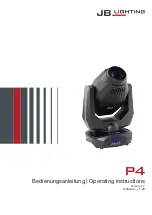
SC932A CS I/O to RS-232-DCE Interface
6
4.3 Testing RAD Modem Communication
The modem communication link is divided into the following three sections:
1) RAD modem computer end, 2) cable from computer modem to data logger
modem, and 3) RAD modem data logger end. When unable to establish
communication with the data logger, test each of the three sections. See a blog
article at:
www.campbellsci.com/blog/test-com-ports-short-haul-modems
Before proceeding through the testing procedures, a terminal emulator software
program such as Campbell Scientific’s
Terminal Emulator
(included with
LoggerNet
,
PC400
, and
Device Configuration Utility
) must be used to
communicate through the COM port of the computer. Once the emulator
program is set up, testing can proceed as follows:
1. Disconnect the four conductor cables from the SRM-6A RAD modem at
the computer end. Jumper the XMT + to RCV + and jumper the XMT – to
RCV –. This creates a transmit loop which allows any key pressed at the
computer keyboard to be seen on the screen. If the key pressed is not seen,
check the following: COM port configuration, 25-pin cable from the
computer to the modem and the RAD modem.
2. Reconnect the four conductor cables to the modem at the computer end
and disconnect the cable from the modem at the data logger end. Twist
together the XMT + wire and RCV + wire, twist together the XMT – wire
and the RCV – wire. Repeat the process of step 1 by pressing a key on the
computer keyboard. If the key pressed is not returned, then the cable from
the modem at the computer to the data logger modem is defective and will
need to be repaired or replaced.
3. If steps 1 and 2 pass, the modem at the data logger is suspect. Disconnect
the modem from the SC932A and bring the modem to the computer site.
Attach the modem to the computer, and repeat step 1 by jumpering the
terminals of the modem and pressing a key on the computer keyboard.
If the above tests pass and communication to the data logger still has not been
established, perform tests 4, 5, and 6.
4. A 12 V lead acid battery supply should not be discharged below 11.76 V.
If this occurs, the batteries will go into a deep discharge state and will
need to be replaced. Check the 12 V supply with a volt meter.
5. On the wiring panel of most Campbell Scientific data loggers there is a
terminal marked 5 V. Check the 5 V supply with a volt meter. This 5 V
supply should be within a tenth of a volt. If not, it would indicate a
problem.
6. To verify that the data logger and its serial I/O port are working, try to
access input memory locations using a laptop PC with the SC32B or the
CR10KD Keyboard Display.
If the data logger passes tests 4, 5, and 6, then the SC932A is suspect and will
need to be repaired or replaced.





























